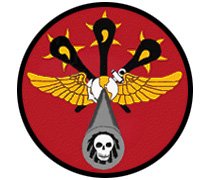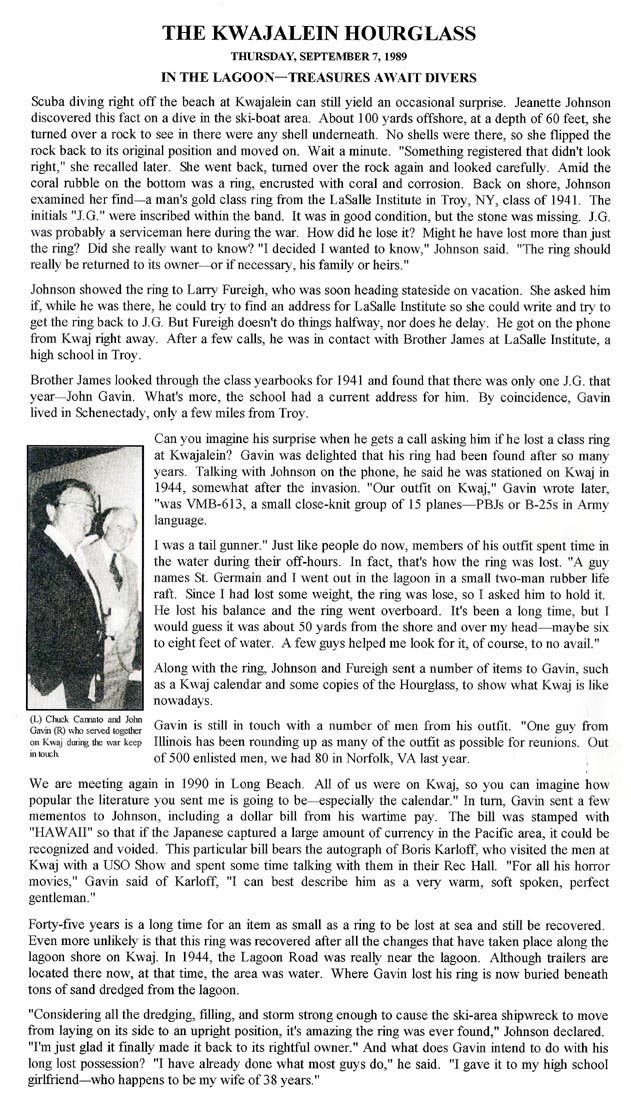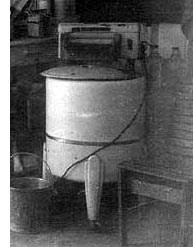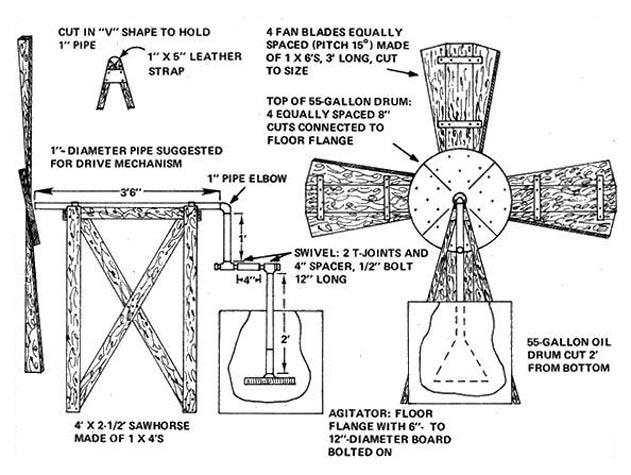|
|
||
|
|
||
|
|
PERSONAL MEMORIES The following collection of personal memories was submitted by squadron members. This collection describes events in various locations while the contributors were serving with Marine Bombing Squadron Six-Thirteen. MARINE CORPS AIR STATION CHERRY POINT, NORTH CAROLINA Pilot Humor: At Cherry Point one of our planes was observed by the control tower landing, apparently without proper clearance. Radioed from the tower came this comment, "Mike Baker-62, If you can hear me, wiggle your wings." The reply from the pilot of the PBJ was, "I will if you will shake your tower." Contributed by Anonymous NAVAL AIR STATION BOCA CHICA, FLORIDA Dangerous Antics: While training at Boca Chica a number of pilots threatened the control tower by banking too close to it upon take-off. As I recall, several were reprimanded for these daring, but careless actions. Contributed by James D. Garls Major Baker is Forced to Ditch: In December, 1943 Major Danser and I were assigned to VMB-613. Major Baker was our new C.O. Lieutenant Al Simmons was my copilot. The rest of the crew consisted of McDonald, Grice, Morris and later Lombardi. After a few months of training we were sent to Key West, Florida to practice torpedo runs. We carried 2,000 pound chunks of concrete in the bomb bay to simulate a torpedo. On one training mission I was flying wing on Major Baker, when his plane started to slow down. I radioed that I was pulling out of formation to see what the trouble was. We circled and watched as Major Baker's plane landed wheels up in the Keys. The water was about four feet deep and the crew climbed out on the wing. We could see one person lying on the wing. This turned out to be Major Baker, who had compound fractures of both ankles. He had both feet on the rudder pedals when the plane crashed and coral tore through the bottom of the plane, causing his injuries. Later we learned that the cause of the crash was that he had a runaway propeller and was unable to jettison the concrete. He could not maintain altitude with such a heavy load and only one engine. Contributed by John W. Keith, Jr. Eleanor Roosevelt's Party: While at Boca Chica we were granted some liberty in Havana, Cuba. Transportation was provided to Batista Field in the squadron's PBJs. On one of these flights, a pilot noticed a party being held on the rooftop patio of one of the hotels in downtown Havana. In an effort to remind them that there was a war going on, he performed a low-level, high speed pass—referred to as "Buzzing" in pilot terminology. This tactic resulted in the party guests ducking and running for their lives from what they expected to be an airplane crash. Unfortunately, it also resulted in some unwanted attention. The party's hostess, rumored to be none other than the First Lady, Eleanor Roosevelt, got on the phone and called the airfield to express her displeasure over the incident. Needless to say, there was severe hell to pay a short time later. Contributed by Anonymous MARINE CORPS AIR FIELD NEWPORT, ARKANSAS Rain and Landing Lights Don't Mix: One night I went on a flight, that produced a frightful experience. We took off in a heavy rain at Newport, Arkansas. After we became airborne the pilot made a sudden bank because he was being blinded by the reflection of the landing lights on the rain. Looking out of a window on the port side I saw that we were not very high above a road and the paralleling power lines. I thought we were about to crash into the ground, but we quickly pulled up. As we rose above the storm clouds the landing lights finally went out. To this day I do not know why the lights were not properly turned off. I suppose it was the duty of the co-pilot, but perhaps he was one of the newly assigned rookies. Contributed by James D. Garls Pies and Liberty Passes: When I was stationed at Newport, I would go home to Cincinnati, Ohio every weekend on a 72 hour pass. While I was home I would help my mother and father out in their bakery each Saturday, then go out in the evening. The trip home took 13 hours, and I recall the ticket cost was $13. How I received these weekend passes was rather interesting. It so happened that our squadron sergeant major, Sergeant Major Abrams, liked pies. Being the squadron baker, he asked me to bake him a pie on one occasion. I baked the pie and delivered it to him. The next day I returned to pick up the pie plate and there was a 72 hour pass for me underneath the empty plate—no explanation. It didn't take me but a minute to "get the drift." I continued to bake pies for the Sergeant Major the whole time we were at Newport, and each time I returned to pick up the empty pie plate, a 72 hour pass was "mysteriously" included with the empty pie plate. Contributed by Norbert J. Gibbs Leaving Newport for California: When we departed Newport for the west coast prior to going to the Pacific, the flight section was to fly to El Paso, Texas. Each plane took its place at the head of the runway. When it was our turn to take off, the pilot revved up the engines to full speed and then almost immediately pulled up the landing gear. I don't know how far we went down the strip before the gear was raised. I do know that we skimmed very close to the ground for a long period of time before we rose to a respectable altitude. I wonder if others recall these take-offs? I think this action was described as "taking off from the step." Contributed by James D. Garls CENTRAL PACIFIC Navy Humor on Eniwetok: A sign above the backbar of the Chief Petty Officer's club at Eniwetok read: "The Marine Corps ain't what it used to be, but it never was!" Contributed by James D. Garls Typhoon Creates Havoc: While heading from California to Pearl Harbor aboard the USAT George W. Julian we encountered a typhoon shortly after we departed. At one point during the storm I was making some chocolate pudding, and I left the galley for a minute to get some fresh air. While I was doing so, the ship hit a very bad wave and dropped into the trough—probably about forty feet. I rushed back to the galley to find that the pudding had been hurled from the bowl, landing on the bulkhead and overhead. It was one hell of a mess! Contributed by Norbert J. Gibbs New Use for Japanese Boats: While on Kwajalein the Marines of the our department acquired a Japanese dory. We repaired it during our off-duty hours and made is seaworthy—we even built a cabin on it. When it was completed we were able to cruise the lagoon and visit many of the islands in Kwajalein Atoll. Contributed by Robert W. Longenberger Attack of the Rats: We had a large number of rats living on Kwajalein. They were huge—about the size of a cat. As I was the squadron baker, I worked in the evening. One night I went into a storeroom to retrieve some supplies. The room was dark, but I went in nonetheless. As I got in the room I felt a jolt as something hit my shoulder. I turned towards the open door where there was some light. As I did this I saw an enormous rat sitting atop my shoulder. I yelled and ran out of that storeroom fast! Fortunately, the rat had had enough too, and jumped from my shoulder onto the floor where is scurried away. I never went into that storeroom ever again. Contributed by Norbert J. Gibbs Cannon's Use Caused Problems: Anytime an aircraft returned from a mission, we needed to find out if the 75mm cannon had been used. If it had, we began a lengthy process to look over the entire aircraft. This was necessary as the firing of that cannon caused hydraulic leaks, and rivets in the airframe to shear-off. We used flashlights and crawled over every inch of the aircraft to locate leaks and damaged rivets so that they could be repaired before the next mission. Contributed by Michael Jacus Jr. Ice Cream on Kwajalein: On Kwajalein we had an ice-cream machine. Unfortunately, no one knew how we were supposed to make ice-cream since we did not have a recipe. I wrote to my mother and asked her to send me the recipe. She sent me the recipe, however the ingredients were not readily available so we had to improvise a bit. We use powdered milk and powdered eggs to make the ice-cream. Then for the flavoring—I used cocoa powder to make chocolate ice cream and strawberry jam to make it into strawberry ice-cream. Contributed by Norbert J. Gibbs High School Ring Lost in the Lagoon: In 1945, squadron member John Gavin lost his high school class ring in Kwajalein Lagoon. Over 40 years later, it is discovered and returned to him. Contributed by John J. Gavin
Unloading Bombs: While working on the flight line one day, we were informed that the mission had been cancelled. As a result, we had to unload the bombs that we had just loaded aboard one of the PBJs. To expedite the unloading process, I came up with an idea. Rather than using the aircraft's internal crank-operated bomb hoisting mechanism to lower them from the aircraft to the bomb truck, we could simply drop them onto the bomb truck after it had been properly positioned. After clearing this idea through the Ordnance Chief, we removed the fuzes, positioned the bomb truck then, using the pilots bomb release switches, dropped each one of them onto the bomb truck. This worked like a charm and soon our task was complete. Sometime during this process the Ordnance Officer drove up in a jeep to check on us. Upon seeing one of the bombs fall from the bomb bay into a truck waiting below, he departed the area at a high rate of speed. From that point on, I don't ever recall him being on the flight line when we had to unload ordnance. Contributed by Robert Shock The Luck of the Draw: When it was discovered that the Japanese were close to making airfield number 2 on Ponape operational, an attack was scheduled for February 6th. My crew was scheduled to fly that mission in the "Love Bug." Our crew consisted of Bob Love, Tom Houston, Joseph Danz, Alvin Klinke, Joseph Brais, Harry Jordan, and me. In the early evening on the day before the raid, an object, believed to be a Japanese submarine, was spotted. As our crew was on standby, we were instructed to investigate. We flew from Eniwetok to the reported location of the sighting. We patrolled the area for quite a while, searching, but were unable to locate anything. We headed back to Eniwetok and landed sometime after midnight on February 6th. Since we had been airborne so long and had gotten back so late, it was decided to replace our crew for the mission. Bill Love and his crew were assigned to replace us on the raid in the same aircraft, the "Love Bug." The six aircraft on the strike left Eniwetok for Ponape a number of hours later as we slept. When we awoke sometime around noon, a message from one of the aircraft on the strike was received indicating that "there had been some problems." We had no idea exactly what this meant as detailed information could not be transmitted for security reasons. We did realize though that it was not good news. After the aircraft landed we learned that Bill Love and his crew had been killed. Contributed by Lloyd L. McDaniel
Marshall Islands Maytag: On Kwajalein, we did as much as we could to make our stay on the island as comfortable as possible. One such device we constructed was a wind-powered washing machine. I referred to them as "Marshall Island Maytags." On Kwajalein, a constant ocean breeze blew across the island so a wind-powered washing machine was very practical. It seemed like there were hundreds of them on the island. On one area of the beach they were lined up in a row. These washing machines were often simple, but every now and then, someone with good resources and a mind for engineering would come up with a newer and more complex design. One in particular had a rotating agitator rather than the simple "up and down" action. I built one for myself and it worked like a charm. The only drawback was that you could not leave your clothing in the washer for too long. One time I put in some uniforms and did not check on it for a few hours. When I finally retrieved my laundry, the machine had ground them into shredded rags from the never-ending action of the agitator. I never let that happen again. Contributed by James D. Garls
MARSHALL ISLAND MAYTAG PLAN: A simple version of a wind-powered washing machine was constructed with a 55-gallon drum, some wood, pipes and scrap metal. Sentimental Journey: The song Sentimental Journey was very popular during the war-time years. I recall one instance in particular hearing it while awaiting the anticipated announcement of the Japanese surrender while we were on Kwajalein. The surrender was broadcast on the radio about 2:00AM, Kwajalein time. Al Rothenbach, who was bunked directly across the isle from me in our barracks, had a short-wave radio. On this special occasion he had obtained permission from the Officer of the Day to extend lights out so that we could listen to the surrender announcement. Prior to the actual announcement the station was broadcasting music. The guys in our barracks were sitting on the floor around Rothenbach's and my cot listening to the music while waiting for the announcement. I drifted off into sleep but awoke up shortly before the announcement with that continuous Kwajalein breeze blowing across my body through improvised openings in the barracks walls below where there would normally be windows. When I awoke, the song being broadcast was Sentimental Journey. Everyone gathered around Rothenbach's cot was sitting there quietly—not a word was to be heard. It was a serene moment that I have had fond memories of throughout my life. Contributed by Clifford L. Dotson Post-War Move: Missing from the squadron's history is the post-war move of the engineering, ordnance, and electronic maintenance facilities from the lagoon side of the taxi strip into Quonset huts further to the north and on the ocean side of the runway. It was done essentially in one very hot afternoon with plenty of beer available. This event gave rise to Lieutenant Colonel Nevils' supposed remark, "Give this squadron enough to drink and they can do anything." Contributed by Samuel A. Wolfe |
|
|
Copyright © 2008 Marine Bombing Squadron Six-Thirteen Association. All Rights Reserved. |
||



 The
Dump: On the approach end of the runway was a dump that
contained all sorts of discarded gear left there by departing
military outfits for various reasons including adjusting their
required inventory. For example, there was roll after roll of
new barbed wire, bomb trailers with Chrysler product wheels and
brand new 6.00 x 16 tires, a light Japanese tank and a myriad of all
kinds of other things. One item retrieved and restored by the
squadron was a small caterpillar tractor. Among the many items
I retrieved or helped retrieve was an on-board power unit for a
Martin PBM flying boat, a Maytag washing machine, and a pair of
damaged Japanese binoculars. The PBM power unit had output
voltages of 24V DC, 32V DC, and 115V AC. It was powered by a
5-cylinder dry sump radial engine mounted with the crank shaft
oriented vertically and had its own air cooling fan that exhausted
out the top. With the help of the radio and radar repairmen, I
rigged an external oil tank, cooler, gas tank and its own battery
and electrical system. It gave the electronics repair people one
relatively quiet power source for their required voltages and
replaced three portable motor-generator sets. Heaven only
knows where the Maytag "wringer-type" washing machine came from in
the middle of the wartime Pacific. The sector gear in the
transmission that drove the agitator was missing a few gear teeth
rendering the washer useless and the electric motor was gone. I
brazed new metal to the sector gear in the area of the missing teeth
and shaped them with a file. The missing motor presented a problem
but after a short period of time this was solved by "picking up" a
small Briggs & Stratton engine during an overnight at Eniwetok. It
was coupled to the washer transmission input shaft and 'Voila', we
had an operating Maytag washing machine complete with a functioning
wringer! Hot water came from a GI-can with a kerosene
salamander heater. Use was restricted to the aircraft Crew Chiefs
to conserve its useful life, and when we departed Kwajalein it was
donated to the USMC base defense outfit. The Japanese
binoculars ended up in Nick Bozic's make-shift photo developing
"dark-room" with the intent of being made into a photo enlarger. I
don't remember if that ever came to fruition. Maybe Nick knows. Contributed by Samuel
A. Wolfe
The
Dump: On the approach end of the runway was a dump that
contained all sorts of discarded gear left there by departing
military outfits for various reasons including adjusting their
required inventory. For example, there was roll after roll of
new barbed wire, bomb trailers with Chrysler product wheels and
brand new 6.00 x 16 tires, a light Japanese tank and a myriad of all
kinds of other things. One item retrieved and restored by the
squadron was a small caterpillar tractor. Among the many items
I retrieved or helped retrieve was an on-board power unit for a
Martin PBM flying boat, a Maytag washing machine, and a pair of
damaged Japanese binoculars. The PBM power unit had output
voltages of 24V DC, 32V DC, and 115V AC. It was powered by a
5-cylinder dry sump radial engine mounted with the crank shaft
oriented vertically and had its own air cooling fan that exhausted
out the top. With the help of the radio and radar repairmen, I
rigged an external oil tank, cooler, gas tank and its own battery
and electrical system. It gave the electronics repair people one
relatively quiet power source for their required voltages and
replaced three portable motor-generator sets. Heaven only
knows where the Maytag "wringer-type" washing machine came from in
the middle of the wartime Pacific. The sector gear in the
transmission that drove the agitator was missing a few gear teeth
rendering the washer useless and the electric motor was gone. I
brazed new metal to the sector gear in the area of the missing teeth
and shaped them with a file. The missing motor presented a problem
but after a short period of time this was solved by "picking up" a
small Briggs & Stratton engine during an overnight at Eniwetok. It
was coupled to the washer transmission input shaft and 'Voila', we
had an operating Maytag washing machine complete with a functioning
wringer! Hot water came from a GI-can with a kerosene
salamander heater. Use was restricted to the aircraft Crew Chiefs
to conserve its useful life, and when we departed Kwajalein it was
donated to the USMC base defense outfit. The Japanese
binoculars ended up in Nick Bozic's make-shift photo developing
"dark-room" with the intent of being made into a photo enlarger. I
don't remember if that ever came to fruition. Maybe Nick knows. Contributed by Samuel
A. Wolfe